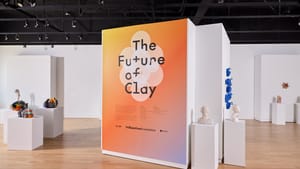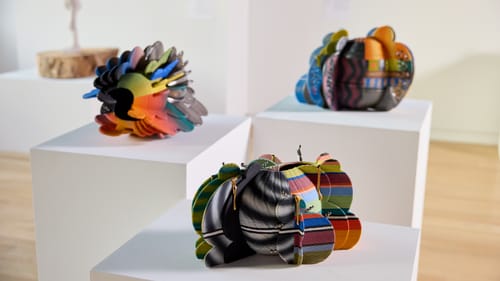Stay in the Loop
BSR publishes on a weekly schedule, with an email newsletter every Wednesday and Thursday morning. There’s no paywall, and subscribing is always free.
What’s next for the enduring art of ceramics?
The Clay Studio presents The Future of Clay

The Clay Studio, a nonprofit arts education and exhibition space in Fishtown, has been celebrating its 50th anniversary all year with retrospective exhibitions like 50 Years in the Making, a where-are-they-now-style look at more than 150 participating artists over the past half-century. Now, for its final exhibition of the year, the Clay Studio fittingly looks toward what’s next in the enduring artistic tradition of ceramic art with The Future of Clay, running through the end of the year.
Curatorial focus
The number of objects in an exhibition can greatly affect its impact. Some shows leave an impression because of the sheer number of items, while others feature a more focused collection. The Future of Clay falls firmly in the latter camp. Clay Studio curator and director of artistic programming Jennifer Zwilling selected three other curators (Anya Montiel, Angelik Vizcarrondo-Laboy, and Zindzi Harley), and they each chose just two artists.
The show’s streamlined look has a two-pronged benefit. First, clean lines allow you to take in eyefuls of juxtaposed artistic sensibilities; shifting your position in the room reveals even more interesting tableaus. Second, patrons using wheelchairs can confidently enter the free, ground-floor level show, where wide swaths of unobstructed hardwood flooring will make their time viewing the objects comfortable and hazard-free. There is also seating on two walls for those who need it.
Cobalt, vessels, and rebellion
The eight artists featured in this exhibition employ a diverse mix of traditional techniques and new technologies, with aesthetics that borrow from their ancestral customs and Western pop culture alike. Standouts include The Blue Print (Indigo Wing & A Poem Full of Corpses), a collection of cobalt wall figurines created by Morel Doucet, a Haitian immigrant who uses disembodied limbs and natural elements to speak about rapid climate change.
Vietnamese American designer Jolie Ngo’s creations and their various chambers are the most fun to look at from various angles. I particularly liked Lantern Vessel in Aerial View, best described as an old-school change purse in the universe of an Escher painting.

Scout, a single piece of the eight made by Chase Kahwinhut Earles, best captured my expectations of the show’s theme. It was made with the traditional pottery methods of the Caddo tribe, which Earles studied extensively as a way to preserve the embers of his culture decimated by conquest and colonialism. Earles frequently creates Caddo versions of Star Wars characters and bots (Star Wars, of course, being one of the most recognizable Western pop-culture depictions of rebellion against empire.) Scout
is reminiscent of the droids used by the Galactic Empire, a mirror to the US Army tactic of hiring Indigenous scouts in their bid to subjugate Native tribes. It has the look of a steampunk contraption, stylishly melding old and new, a visual focal point aided by its position in the room.
Cultural and environmental legacies
It was a sunny, unseasonably warm October day when I visited the show. The radiance pouring through the windows filled the space with a cheerful glow, creating an awful kind of beauty in context. This is best demonstrated by Holly Wilson’s Within We Are the Light, a mixed-media piece of blown glass, bronze, sterling silver, steel, and wood. The figure is modeled after her children and their precious fleeting moments of existence growing, guarded, and guided by her. The piece honors her Delaware/Cherokee Native American family’s legacy of storytelling while also telling the viewer, “We are all the same under the surface.”
Wilson’s figure is intentionally set in the corner, facing the gallery’s large front window, because Wilson wants it to be in conversation with the people of Philadelphia as it is positioned on Lenape homeland. The lighting of a summery October day couldn’t be better for this piece, with its naturalistic futurism sensibility—but the same weather is actually an ill portent for a long and healthy future for humans on this planet. This context both elevates and causes foreboding in equal measure.
Future visitors will probably attend this exhibition after the weather has comported itself to a more appropriate stiff, cold grayness. I wonder what emotions the different weather will evoke, depending on the view out the window.
Disclosure: Writer Crystal Sparrow is employed by the Penn Museum, which has collaborated with the Clay Studio in the past but has no connection to this exhibition.
What, When, Where
The Future of Clay. Through December 31, 2024, at the Clay Studio, 1425 N American Street, Philadelphia. Free and open to the public. (215) 925-3453 or theclaystudio.org.
Accessibility
The Clay Studio gallery is a wheelchair-accessible venue.
Sign up for our newsletter
All of the week's new articles, all in one place. Sign up for the free weekly BSR newsletters, and don't miss a conversation.

 Crystal Sparrow
Crystal Sparrow